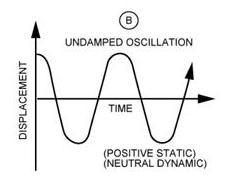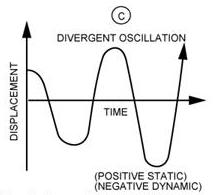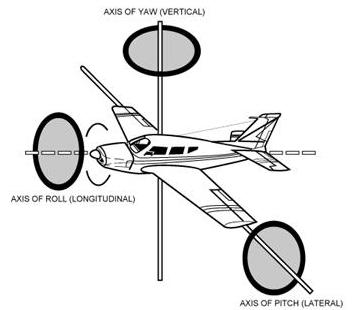


Negative stability is in fact instability and can be illustrated by a ball on the top of an inverted bowl. Even the slightest displacement of the ball will activate greater forces which will cause the ball to continue to move in the direction of the applied force. It should be obvious that airplanes should display positive stability, or perhaps neutral stability, but never negative stability. [Figure 1-19]
Stability may be further classified as static and/or dynamic. Static
stability means that if the airplane’s equilibrium is disturbed, forces
will be activated which will initially tend to return the airplane to its
original position. However, these restoring forces may be so great that
they will force the airplane beyond the original position and continue
in that direction. On the other hand, dynamic stability is a property which
dampens the oscillations set up by a statically stable airplane, enabling
the oscillations to become smaller and smaller in magnitude until the airplane
eventually settles down to its original condition of flight. Therefore,
an airplane should possess positive stability which is both static and
dynamic in nature. [Figure 1-20]
 |
 |
 |
Before further discussion on stability, the axes of rotation will be
reviewed because that is where stability has its effect.
The airplane has three axes of rotation around which movement takes
place. These are:
• lateral axis, an imaginary line from wingtip to wingtip,
• longitudinal axis, an imaginary line from the nose to the tail, and
• vertical axis, an imaginary line extending vertically through
the intersection of the lateral and longitudinal axes.
The airplane can rotate around all three of these axes simultaneously
or it can rotate around just one axis. [Figure 1-21] Think of these axes
as imaginary axles around which the airplane turns, much as a wheel would
turn around axles positioned in these same three planes. The three axes
intersect at the center of gravity and each one is perpendicular to the
other two.
| Rotation about the lateral axis is called pitch and is
controlled by the elevators. This rotation is referred to as longitudinal
control or longitudinal stability.
Rotation about the longitudinal axis is called roll and is controlled by the ailerons. This rotation is referred to as lateral control or lateral stability. Rotation about the vertical axis is called yaw and is controlled by the rudder. This rotation is referred to as directional control or directional stability. Stability of the airplane then, is the combination of forces that act around these three axes to keep the pitch attitude of the airplane in a normal level flight attitude with respect to the horizon, the wings level, and the nose of the airplane directionally straight along the desired path of flight. |

Figure 1-21.—Axes of rotation. |